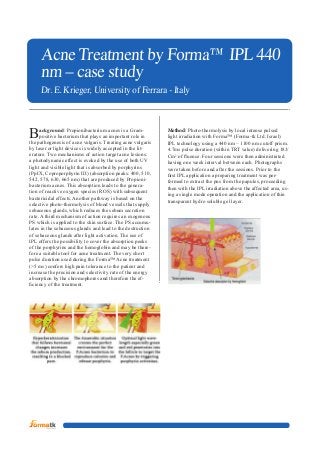
Acne treatment by forma™ ipl 440 nm – case study
- 1. Acne Treatment by Forma™ IPL 440 nm – case study D r. E. Krieger, University of Ferrara - Italy B ackground: Propionibacterium acnes is a Grampositive bacterium that plays an important role in the pathogenesis of acne vulgaris. Treating acne vulgaris by laser or light devices is widely accepted in the literature. Two mechanisms of action target acne lesions: a photodynamic effect is evoked by the use of both UV light and visible light that is absorbed by porphyrins (PpIX, Coproporphyrin III) (absorption peaks: 400, 510, 542, 578, 630, 665 nm) that are produced by Propionibacterium acnes. This absorption leads to the generation of reactive oxygen species (ROS) with subsequent bactericidal effects. Another pathway is based on the selective photo-thermolysis of blood vessels that supply sebaceous glands, which reduces the sebum secretion rate. A third mechanism of action requires an exogenous PS which is applied to the skin surface. The PS accumulates in the sebaceous glands and lead to the destruction of sebaceous glands after light activation. The use of IPL offers the possibility to cover the absorption peeks of the porphyrins and the hemoglobin and may be therefore a suitable tool for acne treatment. The very short pulse duration used during the Forma™ Acne treatment (>5 ms) confers high pain tolerance to the patient and increase the precision and selectivity rate of the energy absorption by the chromophores and therefore the efficiency of the treatment. Method: Photo-thermolysis by local intense pulsed light irradiation with Forma™ (Forma-tk Ltd. Israel) IPL technology using a 440 nm – 1100 nm cutoff prism. 4.7ms pulse duration (within TRT value) delivering 18J/ Cm² of fluence. Four sessions were then administrated having one week interval between each. Photographs were taken before and after the sessions. Prior to the first IPL application a preparing treatment was performed to extract the pus from the papules, proceeding then with the IPL irradiation above the affected area, using a single mode operation and the application of thin transparent hydro soluble gel layer.
- 2. Acne Treatment by Forma™ IPL 440 nm – case study D r. E. Krieger, University of Ferrara - Italy Case: female 24 Y/O affected by moderate Acne Vulgaris. No other systemic medications or treatments were taken during the applications’ period. Pictures show an intermediate results in terms of reduction of the papules inflammatory stage a week after the first session. Conclusion: Acne is a chronic hormonal-genetic disorder; the genetic basis is characterized by numerous transmission patterns, probably related to its wide spectrum of variation. The main factors involved in its etiopathogenesis are hyperkeratinization of the upper portion of the hair follicle, increase in sebaceous production, bacterial colonization of the follicles, and inflam- matory processes in the follicles and the surrounding areas. Forma’s F-AC IPL helps to improve gradually the symptomatic dermis manifestations and to reduce significantly P. Acne levels and consequent inflammatory stage.